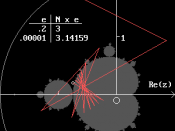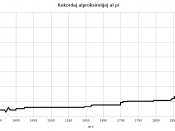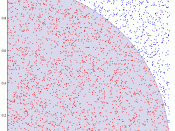The History of the Approximations of p Throughout history, many people tried to find out what the constant was of the ratio of the circumference of a circle to its diameter. There had been many ideas and approximations given to people by the Babylonians, Egyptians, Indians and the Chinese (Archimedes Approximations of Pi). Even in the bible were there references to the approximation of pi. Finally, in 250 BC, a man named Archimedes made a major contribution to mathematics by coming up with a method to approximate the value of pi.
The first calculations of pi occurred in Egypt and Babylon two thousand years before Christ. The approximation that the Egyptians came up with was (4/3)^4 and the Babylonians came up with the value of 3 1/8. Around this same time period the Indians had come up with the approximation of the square root of 10 for pi. All of these approximations were right only to one decimal place.
Also, the use of pi was found in the bible in two different sections. The first being 1 Kings 7:23: ""æand he made a molten sea, ten cubits from one brim to the other: it was round about"æand a line of thirty cubits did compass it round about."� The other verse in the bible is from 2 Chronicles 4:2. It explains the specifications for the great temple of Solomon. So, the value of pi in the bible was approximated to 3 exactly, without any decimal points.
When Archimedes decided to find a better version of pi around 250 BC, he did it very methodically. He decided to find it with the use of polygons. First he found the area of a square inscribed in a circle. Then he substituted a square for a pentagon, then a polygon with sides of 12, then 24, then 48, and ending with 96 sides (Archimedes Approximations of Pi). He realized that the polygons would fit the outside of the circle. When one became too small and then next became too large, he knew that whatever number was in between was the number that he was looking for. That was the number of pi. Today we recognize pi as being either 22/7 or more commonly approximated to 3.14. The actual number is 3.1415926535"æit goes on for over 6.4 billion place values (The Pi Project).
After Archimedes did his work and research, many other mathematicians did some more work on top of his. It started with al'Khwarizmi in 800 AD and he came up with the answer of 3.1416. Then it went to Al'Kashi in 1430 AD who found 14 decimal places after the number. Next was Roomen in 1561 who came up with 17 decimal places. And finally it was Van Ceulen in 1600 who came up with 35 decimal places. Obviously, since today there are over 6.4 billion decimal places, there were many more mathematicians who did much greater work on this (The Pi Project). So really, there was no real progress in the work, just a little more stamina put into it.
It wasn't proven that pi was an exact value or truly irrational until 1761. This was proven by Lambert. But, in 1882, a guy named Lindemann proved that pi was not just irrational, it was transcendental (The Pi Project). This means that it is impossible to represent pi as an exact expression.
The history of pi is a great one that has been going on since sometime way before Christ and will probably continue after we are all gone from this earth. It seems that just more and more people are contributing to the idea of pi and what exactly it represents. The main father of it all though was Archimedes.
BIBLIOGRAPHY "Archimedes Approximations of Pi."� 3 August 1997. On-Line. 8 May 2001.
Available WWW: http://itech.fgcu.edu/faculty/clindsey/mhf4404/archimedes/archimedes.html "The Pi Project."� On-Line. 8 May 2001. Available WWW: http://www.ma.utexas.edu/users/tyilk/PiProj/PiHistory.htm





